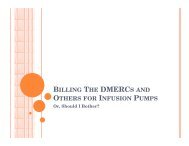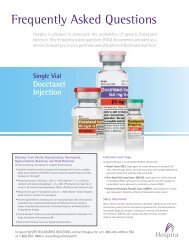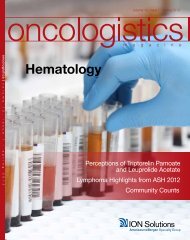oncologistics volume 7, issue 1 - spr<strong>in</strong>g <strong>2008</strong> 18the available cl<strong>in</strong>ical <strong>in</strong>formation. For <strong>in</strong>stance, patientswith appropriate risk factors should undergo test<strong>in</strong>g forHuman Immunodefi ciency Virus (HIV). In older patients withunexpla<strong>in</strong>ed thrombocytopenia, or <strong>in</strong> <strong>in</strong>dividuals <strong>in</strong> whomstandard therapy has not been effective, a bone marrowbiopsy may be <strong>in</strong> order. Correct diagnosis of the etiologyof thrombocytopenia is essential <strong>in</strong> order to provide thecorrect treatment, and to avoid unnecessary proceduresand treatments.MANY PATIENTS WITH THROMBOCYTOPENIAHAVE INCREASED PLATELET DESTRUCT<strong>ION</strong>Non-immune and immune processes can lead to ashortened platelet lifespan. Immune mediated plateletdestruction can occur due to medication, autoimmunity,or alloimmune antibodies follow<strong>in</strong>g sensitization.Medications should always be scrut<strong>in</strong>ized as a possiblecause of thrombocytopenia, s<strong>in</strong>ce the pharmaceuticallist of offend<strong>in</strong>g agents is extensive. Drugs with strongevidence of antibody-mediated platelet destruction <strong>in</strong>cludequ<strong>in</strong><strong>in</strong>e, qu<strong>in</strong>id<strong>in</strong>e, sulfonamides, and gold salts. In additionto the cessation of the offend<strong>in</strong>g medication, there aretreatments for severe thrombocytopenia with bleed<strong>in</strong>gthat may need to be given emergently. These treatmentsmay <strong>in</strong>clude platelet transfusion, corticosteroids, and<strong>in</strong>travenous immunoglobul<strong>in</strong> (IVIG).A special case of drug-<strong>in</strong>duced immune-mediatedthrombocytopenia that is associated with arterial andvenous thrombosis rather than bleed<strong>in</strong>g is Hepar<strong>in</strong>-<strong>in</strong>ducedthrombocytopenia (HIT). HIT occurs <strong>in</strong> 2-5% of patientsgiven unfractionated hepar<strong>in</strong> by any route for fi ve to 10days. Antibodies develop to a complex of hepar<strong>in</strong> boundto PF4 (a prote<strong>in</strong> secreted by activated platelets.) Whenthrombocytopenia is detected <strong>in</strong> a hospitalized patient,HIT must always be considered. If a patient has HIT, allhepar<strong>in</strong> adm<strong>in</strong>istration should be promptly stopped. This<strong>in</strong>cludes subcutaneous <strong>in</strong>jections of “m<strong>in</strong>idose” hepar<strong>in</strong>,hepar<strong>in</strong> fl ushes of IV l<strong>in</strong>es, low molecular weight hepar<strong>in</strong>,and even hepar<strong>in</strong> coat<strong>in</strong>g of <strong>in</strong>travenous catheters.Additionally, at least until the platelet count normalizes,alternative anticoagulation, such as the direct thromb<strong>in</strong><strong>in</strong>hibitors like recomb<strong>in</strong>ant hirud<strong>in</strong> and argatroban shouldbe adm<strong>in</strong>istered. Warfar<strong>in</strong> should not be used <strong>in</strong> cases ofacute HIT because of its delayed therapeutic effect, and itsassociation with venous limb gangrene. S<strong>in</strong>cepatients rarely become profoundly thrombocytopenicby this disease alone, platelet transfusions are typicallynot required. In fact, the adm<strong>in</strong>istration of platelettransfusions <strong>in</strong> this disease is controversial, and somereports suggest platelet transfusions can actuallyprecipitate thrombotic complications.Alloimmune thrombocytopenia is due to sensitization toalloantigens such as Pl A1 , and can result from transfusion(post-transfusion purpura or PTP) or maternal sensitizationdur<strong>in</strong>g pregnancy (neonatal alloimmune thrombocytopeniaor NAIT). PTP causes profound thrombocytopenia 7-10days after exposure to platelets that contam<strong>in</strong>ate redblood cell transfusions, and can be treated with<strong>in</strong>travenous immunoglobul<strong>in</strong> or plasma exchange.NAIT can cause severe thrombocytopenia and bleed<strong>in</strong>g<strong>in</strong> neonates, and is treated with transfusion of plateletsderived from the newborn’s mother, corticosteroids,and <strong>in</strong>travenous immunoglobul<strong>in</strong>.Autoimmune thrombocytopenia, also known asidiopathic thrombocytopenic purpura, is caused bycirculat<strong>in</strong>g anti-platelet autoantibodies. An ITP-likepicture can also occur <strong>in</strong> autoimmune diseases suchas systemic lupus erythematosis, <strong>in</strong> patients withlow-grade lymphoproliferative disorders such as chroniclymphocytic leukemia, and <strong>in</strong> patients with HIV <strong>in</strong>fections.ITP can occur <strong>in</strong> patients of either sex, at any age, andmay present with either mucocutaneous bleed<strong>in</strong>g orunexpla<strong>in</strong>ed asymptomatic thrombocytopenia. Exceptfor thrombocytopenia, the CBC is completely normal.Splenomegaly is absent <strong>in</strong> this disorder, and peripheralblood smears are only remarkable for a decreased numberof platelets, some of which may be larger <strong>in</strong> size thannormal. Bone marrow exam<strong>in</strong>ation is usually not necessary<strong>in</strong> the absence of other fi nd<strong>in</strong>gs suggest<strong>in</strong>g myelodysplasia.When done, the bone marrow biopsy typically showsnormal or <strong>in</strong>creased numbers of megakaryocytes, but isotherwise normal.Management of ITP is guided by both symptoms andplatelet count. Asymptomatic patients with plateletcounts of greater than 30,000/µL can be followedwithout treatment. With bleed<strong>in</strong>g and/or a platelet
oncologistics thrombocytopeniacount of less than 30,000/µL, treatment withprednisone is recommended. Refractory patientsmay require splenectomy (60-75% remission rate),other immunosuppressive medications, or (pend<strong>in</strong>gFDA approval) new thrombopoiesis stimulat<strong>in</strong>gagents. Emergent presentations of ITP with severethrombocytopenia (less than 5,000/µL) and/or <strong>in</strong>ternalbleed<strong>in</strong>g, should be treated with high doses of pulsecorticosteroids and <strong>in</strong>travenous immunoglobul<strong>in</strong>.Platelet transfusion may be given concurrently withthe <strong>in</strong>travenous immunoglobul<strong>in</strong> for critical bleed<strong>in</strong>g.In Rh+ patients, who have not undergone splenectomy,anti-D immune globul<strong>in</strong> may be substituted for<strong>in</strong>travenous immunoglobul<strong>in</strong>. However, occasionalpatients will develop severe autoimmune hemolysisfrom the adm<strong>in</strong>istration of this treatment.THROMBOCYTOPENIA DUE TO DIC, TTP/HUS,AND HYPERSPLENISMNon-immune mediated causes of platelet destruction<strong>in</strong>clude sepsis, dissem<strong>in</strong>ated <strong>in</strong>travascular coagulation(DIC), thrombotic thrombocytopenic purpura/hemolyticuremic syndrome (TTP/HUS), preeclampsia/eclampsia,cardiopulmonary bypass, and giant cavernoushemangiomas. The thrombocytopenia resolveswith treatment of the underly<strong>in</strong>g disorder, andplatelet transfusion is rarely necessary. In TTP/HUS,thrombocytopenia is associated with thrombosis ratherthan bleed<strong>in</strong>g, and controversial reports exist of cl<strong>in</strong>icaldeterioration follow<strong>in</strong>g platelet transfusion.Approximately 20% of the circulat<strong>in</strong>g platelet massis normally present <strong>in</strong> the spleen. Additional plateletsmay be sequestered when the spleen enlarges dueto portal hypertension or <strong>in</strong>fi ltrative diseases, and thisresults <strong>in</strong> thrombocytopenia (although the platelet countis generally are not lower than 40,000-50,000/µL.)Consequently, bleed<strong>in</strong>g due to thrombocytopenia fromhypersplenism alone is unusual.marrow is replaced by metastatic carc<strong>in</strong>oma,fi brosis, or other clonal hematopoietic disorders;follow<strong>in</strong>g chemotherapy and/or radiation therapy;with ethanol toxicity; and dur<strong>in</strong>g <strong>in</strong>fections with virusessuch as HIV, cytomegalovirus (CMV), Epste<strong>in</strong>-Barrvirus (EBV), and varicella. Thrombocytopenia alsooccurs when normal megakaryocyte proliferation isimpaired by myelodysplasia.Overt bleed<strong>in</strong>g <strong>in</strong> these disorders, when clearlydue to thrombocytopenia, is treated by platelettransfusion. However, <strong>in</strong> the absence of bleed<strong>in</strong>g,prophylactic platelet transfusion is an area of controversy.When mak<strong>in</strong>g the decision whether to treat a nonbleed<strong>in</strong>gpatient with thrombocytopenia, the practitionermust consider the short lifespan of platelets (10 days),the fi ve-day shelf life of stored platelets, and the potentialof a transfusion <strong>in</strong>duc<strong>in</strong>g platelet alloantibodies. Inpatients undergo<strong>in</strong>g treatment for acute leukemia,outcome is unchanged when platelet counts as lowas 5,000-10,000/µL are used as the threshold forprophylactic transfusion. S<strong>in</strong>gle donor apheresis platelets,and/or platelet donors who are HLA-identical to therecipient, should be used to prevent alloimmunization.The multi-center Platelet Dose trial is currently underwayand should help to clarify the ideal parameters for platelettransfusions <strong>in</strong> patients with malignancy.FINAL THOUGHTSThrombocytopenia rema<strong>in</strong>s a potentially life-threaten<strong>in</strong>gproblem that requires careful cl<strong>in</strong>ical assessmentand judgment. In recent years, signifi cant advanceshave been made <strong>in</strong> elucidat<strong>in</strong>g the pathogenesisof thrombocytopenia and the mechanisms ofthrombopoiesis. Draw<strong>in</strong>g upon decades of basic scienceand cl<strong>in</strong>ical research, this has led to the application ofsafer and more effi cacious therapies for this disorder. ❚DECREASED PLATELET PRODUCT<strong>ION</strong> INTHROMBOCYTOPENIADecreased platelet production occurs <strong>in</strong> primarydiseases of the bone marrow such as acute leukemiaand aplastic anemia; myelophthisic processes <strong>in</strong> whichCharles S. Abrams, M.D., is associate professor<strong>in</strong> the Department of Medic<strong>in</strong>e at The Universityof Pennsylvania School of Medic<strong>in</strong>e.oncologistics 19














